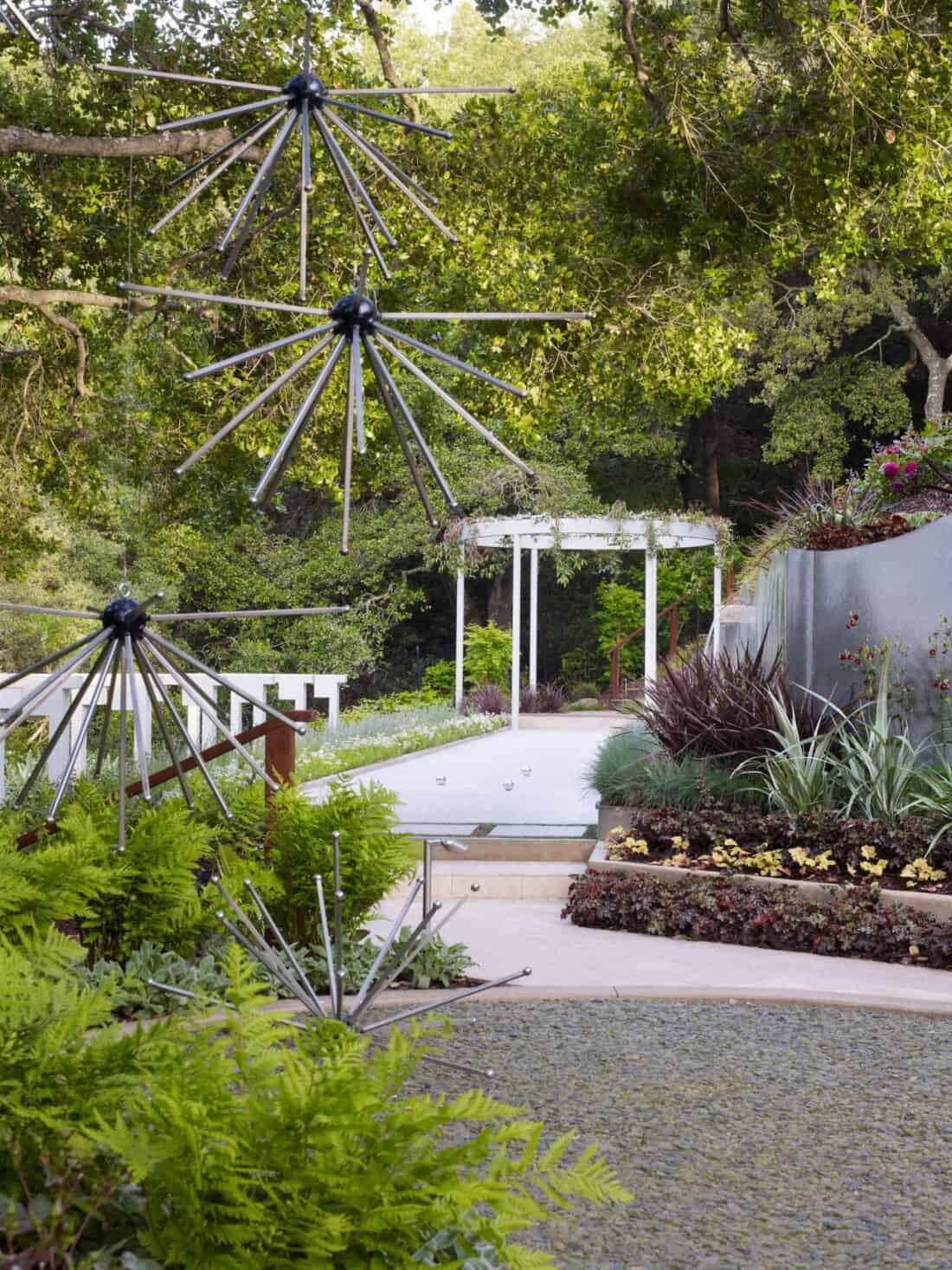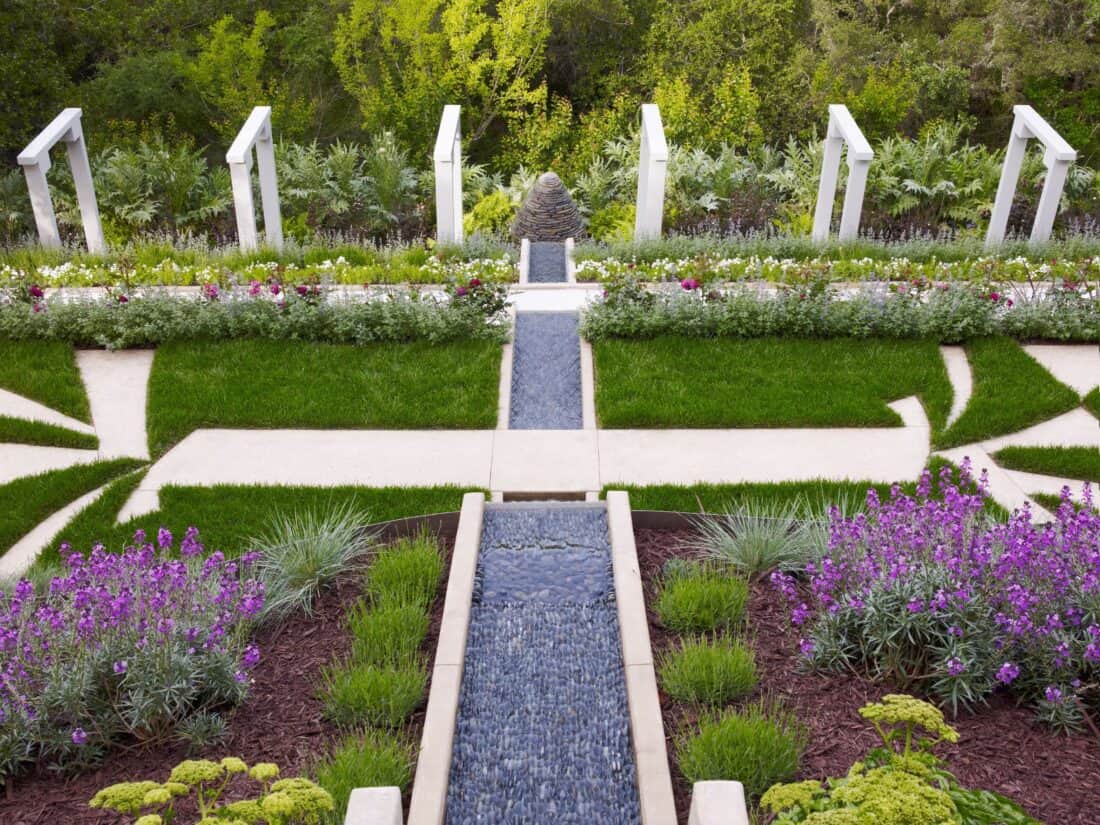In my book (Cultivating Garden Style, Timber Press 2014), I dubbed a garden-style “Earthy Contemporary”. I made up the name, so if you’ve heard of it, you know its origin. I illustrated my breakdown of this garden style with images from a contemporary garden designed by the California landscape design firm Zeterre.

This is how I described Earthy Contemporary (back in 2012 – which is important to note for this conversation – it’s more than a decade later now, and I think it is worth pondering what has changed):
Modern Vs. Contemporary in Landscape and Garden Design
I used to struggle to understand the nuanced difference between contemporary and modern design. But there is a difference worth understanding. Contemporary is now (like right now), it is of the moment and it is constantly changing. Conversely, ‘modern’ is a notable design movement that started in the 1950’s and was marked by a dramatic break from the ornate interiors and home decoration that had been the fashion prior. Long low and clean lines, neutrality with color pops here and there and big expanses define modern. We all like to call the movement and style Mid-Century Modern these days – which is fine – but really it is just modern.
The thing about ‘modern’ is that it is still relatively new and its influence pervades what we call contemporary. Contemporary is what we are doing in the current moment. My favorite explanation is from blogger Lindsay Nealon at Urban Domesticity – “Yesterday’s contemporary is today’s vintage. And tomorrow’s contemporary is still unknown”. We can all agree that we often think of Mid-century Modern (which is modern) as vintage these days, right?
So when we talk about contemporary – we have to get ourselves on the same page – currently it is heavily influenced by modern design, meaning that is full of long straight lines and a tendency to be restrained in intricate details but it also a few other things…it is looser and more livable, it is earthy, it is reflective of the fact that we are kind of into mixing things up these days (we call this eclectic) and that we are constantly evolving and experimenting.
Rochelle Greayer – Cultivating Garden Style (written in 2012 – published by Timber Press in 2014)
Here are a few more images of the Cypress Ridge Garden as Designed by Zeterre Landscapes.

Earthy Contemporary – Defining The Garden Style
What are the main characteristics that define (or defined) the Earthy contemporary style (back in 2012)? This is what I saw then, and I’m enjoying revisiting this (in 2024) to see how contemporary garden design is still in line with what it was ten years ago.

Geometric Layouts & Details
Straight-line paths made of square or circular pavers are typically modern. Spheres, cylinders, cones, and cubes can be reflected in everything from furniture and sculpture to plants. This sort of mathematically based orderliness can be a soothing and relaxing contrast to our chaotic lives. Use geometry but keep it current by not being a slave to it and let in elements that catch your fancy. Create contrast with a wild and floriferous planting below a strictly rigid line of trees or juxtapose ornate and old-fashioned furnishings – re-furbished in an up-to-date color – and use them as a focal point in an otherwise spare garden. This square patio is created with stacked square cut stones, but it is softened with gravel and casual, irreverent planting.

Modern Materials
Chunky wood, metals (both shiny and rusted) and concrete are cost effective, easy to use, and readily available – so put them to good use. Use them in as many ways as you can imagine. Turn industrial screens into trellis, or decorate walls with slices of railway sleepers, use rebar to screen off an area or make your own custom containers from concrete and Hypertufa techniques. Combine these with other modern materials like glass, sheet metals and plastics to create new finishes, shapes and options for your contemporary garden.

Use Punchy Color (especially in plants)
Play with color and use it to tie things together or make a point. Contemporary gardens often use lines of brightly colored plants to draw lines or shapes on the landscape.
An otherwise neutral (as in all greens and browns) can get a shot of colorful surprise by dropping in a magenta set of bench cushions or punctuating a path with a bright red maple. Smooth cobbles can come in a variety of colors ranging from black to brown to white, and these can also be used to create blocks of colorful contrast. It is often common for the interior finishes to be carried outside.
Try this out by using the same color scheme for an adjacent interior room but paint in plants and flowers outside. Unusual colors work well on walls and other hard landscaping features. Be brave (it is usually just paint), and create a strong color theme for your garden.

Less is More
Use as few kinds of materials, colors, and plants as you can and then get creative with making a big statement with what you have. Also, try to carry something through the garden from indoors. The flooring in your open-plan kitchen can carry through in color and style to the decking just outside. Alternatively, you can make a connection by using tiles with other details like stainless steel accents. Contemporary gardens are a reflection of our lives – we don’t have as much time to garden as we might like, so keep it easy by keeping less.

Has Contemporary Garden Style Changed in the last 10 years?
I’d love to know what you think (tell me in the comments!) – but these are my thoughts on how contemporary design has evolved (at least since I wrote my book).
Contemporary garden design is all about clean lines and functionality – minimalism and a focus on less being more. I think the main elements of strong geometric shapes, open spaces and restrained and striking color palettes are still strong design trends BUT I think there is a shift to choose softer more natural and textural materials (I don’t thinK you will see so much of the shiny metal panels for example). Recycled materials (or the ability to be recycled) and sustainability are also an ever increasing consideration – and all of it is leading to a softening of the contemporary design starkness of a decade ago.

The materials have also evolved to include not just more sustainable and but locally sourced options, as well as innovative products like permeable pavers and green options.
When you also take into consideration the rapid adoption of naturalistic planting styles that focus more on native plants, the already popular trend is growing as gardeners and designers aim to create even more resilient and self-sustaining landscapes.
Contemporary garden design continues to evolve, reflecting broader trends in sustainability, technology, and lifestyle changes. Over the last decade, there’s been a noticeable shift towards more sustainable practices. These changes have made contemporary gardens more resilient, versatile, and in tune with the natural environment.
The garden designed and images by Zeterre
